Basement Home Theater Set Up & Wiring
When I moved to GA in September 2007, one of my absolute requirements for a house was that it needed a basement. I've had a dream for a long time of having my very own dedicated home theater in my basement. I didn't have a budget for top of the line components or anything fancy, just something that I built myself. The main components I needed for my DIY basement home theater were Receiver, Projector, Speakers, Seating and Video Sources such as a Playstation 3. Fortunately for me, the previous owners had completely finished the basement including a drop tile ceiling. That drop ceiling made it very easy for me to run cables above the ceiling and through walls. When I decide to add something to my setup, I can easily just remove the ceiling tiles and run more cables. If I wasn't fortunate enough to have a drop ceiling previously installed, I likely would have used raceways to run the cables. Another idea to hide cables is to install crown molding around the room and leave a channel inside large enough to run cabling through. Of course there is always the age-old method of removing sections of the drywall and running cables properly through the walls. That sounds like a lot of work and was a bit outside of my skill set.
The eventual layout for my DIY basement home theater was fairly straight forward. With the various doors, closets and single window I really only had one choice on where the screen would be located. I didn't want my receiver and other devices to distract from the movie, so the plan was to use the adjacent closet as my mini media room. This closet is basically my man/nerd closet. It houses my home theater components, beer/mead making equipment, and comic book collection.
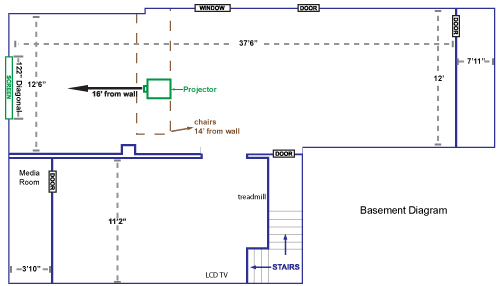
Basement layout diagram (click for larger image)
 My receiver is the heart of everything. It accepts multiple sources, and
outputs video to my projector and audio to my speakers. I read reviews, and I
read forums looking for mid range receivers with the features I wanted. My
requirements in a receiver were: 7.1 surround audio; 3 or more HDMI inputs; 1
or more HDMI outputs; and the ability to accept any video signal type, and
output through a single HDMI. I found all the features I wanted in the Onkyo
TX-SR805 AV receiver. The only negative aspect I read about this receiver was
that it had a tendency to overheat. My basement media room is a large closet, so that
was not an issue for me. In the spirit of not taking any chances, I got a
rack that has plenty of airflow.
My receiver is the heart of everything. It accepts multiple sources, and
outputs video to my projector and audio to my speakers. I read reviews, and I
read forums looking for mid range receivers with the features I wanted. My
requirements in a receiver were: 7.1 surround audio; 3 or more HDMI inputs; 1
or more HDMI outputs; and the ability to accept any video signal type, and
output through a single HDMI. I found all the features I wanted in the Onkyo
TX-SR805 AV receiver. The only negative aspect I read about this receiver was
that it had a tendency to overheat. My basement media room is a large closet, so that
was not an issue for me. In the spirit of not taking any chances, I got a
rack that has plenty of airflow.
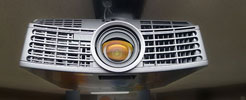 I did research for months, trying to figure out which projector was going to
provide a high quality picture while keeping within my sub $1000 budget. My
eventual decision landed me with a brand new Mitsubishi HC1500 720P
projector. This purchase was 4 years ago, so while 1080P projectors were
certainly around, none of them came anywhere close to my target price. I
wanted the screen to fit most of the wall in my basement. I settled on a
122" diagonal measurement. This projector was easily capable of this
size of an image, and with only one window in the basement, light control is
not a problem. Every projector needs a screen to display movies on. A
professional screen the size of what I wanted was extremely expensive. I
looked around online for DIY (Do It Yourself) ideas, and found several
options. I found special paint that you simply paint on to your walls with a
painted black border around it. I also read about using sheet fabric
stretched around a frame. I didn't like the idea of the painted wall, but
the sheet stretched around a frame sounded interesting. I researched more
into it, and I found a better material to use called blackout cloth. Blackout
cloth is what is used in hotel windows that completely blocks out any light.
I got an appropriately sized piece of that cloth for about $100, and built a
frame to my dimensions out of 2x4s. Once I stretched the cloth around the
frame, I had my screen.
I did research for months, trying to figure out which projector was going to
provide a high quality picture while keeping within my sub $1000 budget. My
eventual decision landed me with a brand new Mitsubishi HC1500 720P
projector. This purchase was 4 years ago, so while 1080P projectors were
certainly around, none of them came anywhere close to my target price. I
wanted the screen to fit most of the wall in my basement. I settled on a
122" diagonal measurement. This projector was easily capable of this
size of an image, and with only one window in the basement, light control is
not a problem. Every projector needs a screen to display movies on. A
professional screen the size of what I wanted was extremely expensive. I
looked around online for DIY (Do It Yourself) ideas, and found several
options. I found special paint that you simply paint on to your walls with a
painted black border around it. I also read about using sheet fabric
stretched around a frame. I didn't like the idea of the painted wall, but
the sheet stretched around a frame sounded interesting. I researched more
into it, and I found a better material to use called blackout cloth. Blackout
cloth is what is used in hotel windows that completely blocks out any light.
I got an appropriately sized piece of that cloth for about $100, and built a
frame to my dimensions out of 2x4s. Once I stretched the cloth around the
frame, I had my screen.
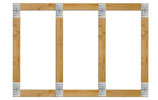

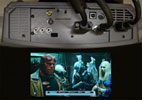
Back of screen, frame and Theater in action
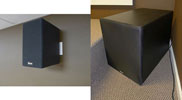 When it came time to shop for a subwoofer and basement surround sound system, I once again
spent a lot of time in online forums reading opinions and experiences. A
company called SVS came up, and their subwoofers were very highly regarded as
great quality at a fair price. I got their SVS PB12 NSD subwoofer and their 7
standard speakers.
When it came time to shop for a subwoofer and basement surround sound system, I once again
spent a lot of time in online forums reading opinions and experiences. A
company called SVS came up, and their subwoofers were very highly regarded as
great quality at a fair price. I got their SVS PB12 NSD subwoofer and their 7
standard speakers.
I already had a Playstation 3 and a Nintendo Wii, so I didn't need any extra sources for content other than cable TV or Satellite TV. My current TV provider is DirecTV. I have one of their HD DVRs, and I really can't imagine life without being able to record whatever show I want. They have served me well with a huge lineup of HD channels and great customer service. Other cable TV or Satellite TV providers that offer similar services are Dish Network, Verizon Fios, AT&T Uverse, Comcast, Cox, etc.

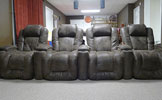 I have a fond memory of watching Indiana Jones and the Last Crusade in my
basement with my wife while sitting in lawn chairs. However, 3-4 months of
watching movies in lawn chairs kicked the search for theater seats into high
gear. We ordered the seats, and waited another 6 months to get them because
they were custom made. As one purchase, the 4 theater seats were easily the
most expensive component. Part of my DIY basement home theater dream included stadium
seating. So I got 2x12 pieces of wood, and built a 12" tall, 4'
deep, and 8' wide platform for stadium seating. I had two seats on that
platform, and two seats in front of it. That took up a lot of floor real
estate for kids running around and playing so the seating platform was moved
to it's current location and is now known as "the stage". I now
have one single row of seating and I like it much better.
I have a fond memory of watching Indiana Jones and the Last Crusade in my
basement with my wife while sitting in lawn chairs. However, 3-4 months of
watching movies in lawn chairs kicked the search for theater seats into high
gear. We ordered the seats, and waited another 6 months to get them because
they were custom made. As one purchase, the 4 theater seats were easily the
most expensive component. Part of my DIY basement home theater dream included stadium
seating. So I got 2x12 pieces of wood, and built a 12" tall, 4'
deep, and 8' wide platform for stadium seating. I had two seats on that
platform, and two seats in front of it. That took up a lot of floor real
estate for kids running around and playing so the seating platform was moved
to it's current location and is now known as "the stage". I now
have one single row of seating and I like it much better.
All of my source devices are high def with an HDMI output with the exception of my Wii. This made all the connections simpler than they would have been otherwise. As previously stated, my source devices are a Playstation 3, a Wii, and a DirecTV HD DVR. The Playstation 3 and the Wii are both located in my media room in the basement. The HD DVR sits beneath my Sony Bravia HDTV in the upstairs family room. I'll start with the HD DVR as it is the most complicated part. I wanted to be able to watch recorded shows from the HD DVR on our family room HDTV as well as in the basement. To accomplish this, I use a short 3 ft High-speed HDMI cable from the HD DVR into a HDMI splitter box. The splitter box has 2 HDMI outputs. Output #1 goes to my HDTV in the family room, and output #2 has a 100ft HDMI cable leading into my basement. This 100 foot HDMI cable has a built in amplifier to carry the signal without any loss of picture quality. To avoid any extra connections on the 100 foot HDMI run to the basement, I use a pass through wall plate instead of terminating a cable. Believe it or not, I actually have the other end of the 100ft HDMI cable connected into another HDMI splitter box in the basement. Output #1 goes to my receiver. Output #2 goes to a smaller 32 inch Panasonic HDTV that my wife watches in the basement while running on the treadmill. I do have an IR receiver setup in my basement for controlling devices, but I did not need this for my DirecTV HD DVR. Some clever person decided it would be a good idea to equip their HD DVRs with an RF signal reader. So I bought some extra controllers capable of the RF signal, set my HD DVR to RF mode and I can now control that one single HD DVR from anywhere in my house (Or outside my house too. I never thought about that until right now. Hmm...).
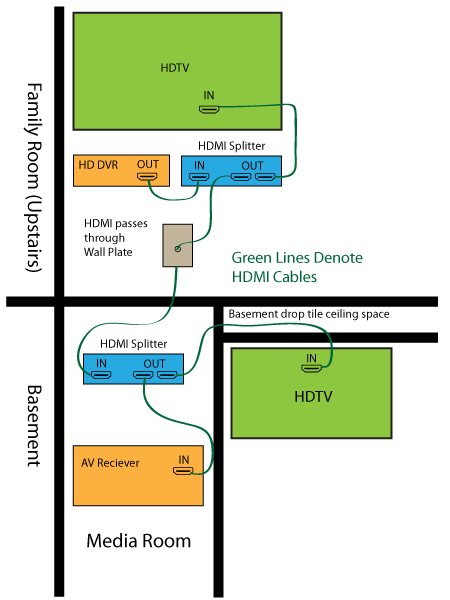
HDMI splitters diagram
The Playstation 3 is connected directly to the Onkyo receiver via HDMI, and the Nintendo Wii is connected directly to the receiver via Component video. My receiver is capable of sending all of those connections through its single HDMI output to the projector. That functionality of the receiver was one of my main requirements.
My surround sound speakers are connected to the Onkyo receiver with 16 gauge speaker wire. The longest single line of speaker wire is to my right rear speaker, which is 30 feet total, so 16 gauge is plenty thick enough for my setup. I used wall plates with Banana plugs to make this connection look cleaner.
Hooking up my computer was not something I intended to do very often, so I was not upset that my receiver does not have the ability to accept SVGA. Instead, I just installed a SVGA with 3.5mm wall plate on the wall with an SVGA Cable going directly to the projector, and the 3.5mm cable going to the receiver. That handles my laptop computer on the rare occasion I want to use my projector as a monitor.
 In order to control my devices, I had to think of some way to get the remote
control signal into my media room. I already touched on my DirecTV HD DVR box
having RF capabilities. That was very convenient and simplified things. The
Playstation 3 was a non-issue as it uses bluetooth to make its connection.
Much like the DirecTV HD DVR, I could control the PS3 from any room in my
house regardless of walls. The Nintendo Wii comes with a sensor that it
supposed to be placed above or below your TV. In my case, the sensor bar sits
on top of my screen. The cord it came with was plenty long, so that also
became a non-issue. The only component that I had to find a solution for was
the Onkyo receiver. I used an IR repeater kit to send the signal from my main
theater area into the media room. The only part of the IR target that you can
see in the Home theater room is a little button on the wall. The button is
connected to the IR main unit via CAT5E cable. Normally, there would be an IR
flasher that was taped to the front of a device and flashed the IR signal
from the main unit. My receiver has a 3.5mm input on the back of it that
accepts the IR signal. So I use a 3.5mm male to male cable from the IR main
unit to my receiver.
In order to control my devices, I had to think of some way to get the remote
control signal into my media room. I already touched on my DirecTV HD DVR box
having RF capabilities. That was very convenient and simplified things. The
Playstation 3 was a non-issue as it uses bluetooth to make its connection.
Much like the DirecTV HD DVR, I could control the PS3 from any room in my
house regardless of walls. The Nintendo Wii comes with a sensor that it
supposed to be placed above or below your TV. In my case, the sensor bar sits
on top of my screen. The cord it came with was plenty long, so that also
became a non-issue. The only component that I had to find a solution for was
the Onkyo receiver. I used an IR repeater kit to send the signal from my main
theater area into the media room. The only part of the IR target that you can
see in the Home theater room is a little button on the wall. The button is
connected to the IR main unit via CAT5E cable. Normally, there would be an IR
flasher that was taped to the front of a device and flashed the IR signal
from the main unit. My receiver has a 3.5mm input on the back of it that
accepts the IR signal. So I use a 3.5mm male to male cable from the IR main
unit to my receiver.
Everything in my dedicated basement home theater setup currently works, and we love watching movies and TV shows in the basement. I do have more work to do, and I doubt I will be completely done for quite some time. I would eventually like to take all of the ceiling tiles down and paint them a matte black. That would cut down on excess light reflecting off the ceiling. I also need to build a black frame around the screen. I have the idea in my head of using some sort of foam board with black fabric wrapped around it. My screen is built to a 16:9 aspect ratio. A black frame would make the colors in movies pop, and it would allow me to easily cover the black bars when I watch movies in 1.85:1 or 2.35:1 aspect ratios.














